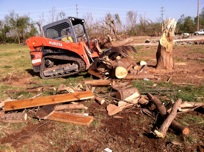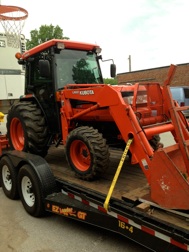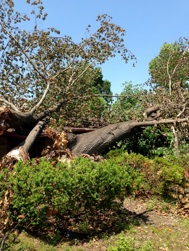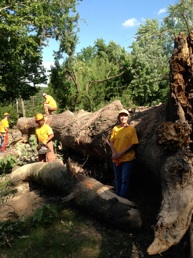Ron Morton’s Rattlesnake Roundup

If you’ve ever encountered a rattlesnake in the wild, then you have felt the uneasy excitement their loud warning gives off. That is if you were lucky enough to get their rattled warning! Most of us try our best to avoid these deadly snakes even while others actively search them out. Call it fun or call it crazy, but for Great Plains customer, Ron Morton, it’s too exciting to pass up. Great Plains living had the opportunity to ask Morton a few questions about why he partakes in this dangerous activity.
GPL: How long have you hunted rattlesnakes?
Morton: I started hunting them when I was 22 years old.
GPL: Who taught you how to hunt them?
Morton: A friend of mine from eastern Okla.
GPL: Why do you hunt them, and what do you like best about capturing these snakes?
Morton: Hunting rattlesnakes is just something I love to do. Some people collect things or work on cars. I catch rattlesnakes. Hunting them is exciting. It really gets your adrenaline pumping!
GPL: Have you ever been bitten?
Morton: No, and I don’t plan on it either!
GPL: Where do you hunt?
Morton: You have to go where the snakes are. I do a lot of my snake hunting in the Arbuckle mountains, but I also go to eastern and western Okla. to hunt them.
GPL: When is the best time of the year to find them?
Morton: The best time is in the spring, typically from February to April. It really depends on the weather.
GPL: How do you go about capturing them?
Morton: Basically you just sneak up and grab them. I use a catch pole to catch and handle the snakes. You have to know and go where the dens are. During the cooler months you can easily catch them sun bathing around their dens on a warm day.
GPL: Do you have any honey holes that always produce lots of snakes?
Morton: Not really. Once you find a den you can usually count on catching snakes there consistently. Usually I hunt a particular den for two or three years making sure not to take the small snakes, and then I will back off of it. You don’t want to over harvest a den.
GPL: What do you do with them after you catch them?
Morton: Sometimes I sell them and occasionally I’ll go to tournaments. I made a belt once, but it didn’t turn out that great.
GPL: How has your Kubota RTV900 aided your hunts?
Morton: We love it! We don’t have to take multiple ATVs because it can hold all of us. It goes anywhere and makes hauling our catch real easy.
Rattlesnake hunting may not be for everyone, but for Ron Morton, it’s
just another reason
living in a plains
state is so great!
Great Plains customer uses his Kubota RTV 900 in an Exciting way
Featuring the Polaris RZRs
Riding The Red
If you are in the market for a new ATV or Side-by-Side but aren’t quite sure which brand to buy, take a drive to the Oklahoma/Texas bridge west of Waurika. Go early on a Saturday or Sunday morning when riders are unloading their machines to ride on the Red river. Compare and count the number of Polaris machines that are being off-loaded to the manufacturers, of other machines.
This scenario is often used by Anthony Giroir, Great Plains Manager in Duncan, when describing the popularity and usage of Polaris off road vehicles. Giroir’s Polaris of choice is a RZR S which he frequently rides on the Red river with a group of friends and family. The long sandy stretches of our numerous river beds are a favorite location to ride for many Oklahoma powersports enthusiasts. After all, nothing says off-roading better than sand, sun, water, mud, catfish, and most notably, a Polaris Ranger RZR S.
Giroir has been riding at the Red river for about a year now. Typically, he rides with a group which consists of five to six couples and often includes their children. Chris James, a friend of Giroir’s, has property on the river and is currently building the River Run RV Park. It is this location that allows easy access for the group. Giroir has experienced many relaxing days on the river while riding various off-road machines. He mentioned that four wheelers are fun to ride on the river as well as the Polaris Ranger, but for the mud slinging, fast paced riding that he and his wife Bobbie do, their Polaris RZR S performs the best.
The Polaris RZR S boasts a wider base and a sport tuned suspension making it’s design optimal for wide open spaces. It has a low center of gravity and can accelerate from 0 to 35 in 3.8 seconds. The RZR S attributes its incredible horsepower to the low vehicle weight and its 800 EFI high output engine. Another feature that makes the RZR S perfect for driving the river bottoms is Polaris’s on demand true all-wheel drive. The AWD gives superior grip to put the 12 inches of suspension travel to work in the sandy dunes and knolls of the Red. Giroir commented on how much he loved his RZR S.
“You can’t beat the ride that this machine has. It is the smoothest riding machine I have been on. Some of my friends drive other brands, and there is no comparison. For the river, the RZR S is perfect because you can haul your gear and ice chest yet still have the power and agility needed for a high performance ride. There are a few accessories for the RZR that you need when spending a full day on the river. A top, and at least a half windshield are a must. Other accessories that are nice to have are a winch, stereo, and brush guards,” said Giroir.
There seems to be a connection that off road riders share. Whether gained from assisting other riders that get stuck or spending time with family. The group that Anthony Giroir rides with gets more from the human experience than the powersports experience. The sharing of experiences and a way out of the normal routine of life is what Polaris offers. Pete Godin has been going on the river for ten years and loves going out with this group.
“I like getting together with friends and family, catching fish the redneck way, and driving on the river. I work out of town a lot, so this is a good way to relax and have fun with the people whose company I enjoy,” said Godin.
When asked what he liked best about time spent on the Red Giroir had this to say. “In the past my wife would do her thing (work in the yard), and I did mine (hunt or fish). Since we bought our RZR S, we go to the river and ride together. It so relaxing and loads of fun. The more friends and family that come, the better.”
Kayla Giroir and Chad Bailey are another couple that ride with this group.
Kayla Giroir summed her experience up in a concise way. She said, “Everyone has their own thing they enjoy. We prefer the river because we can ride for miles and when we get hot or just want to relax, we can stop and get in the water, hangout, or noodle. The men typically handfish while the women laugh at the men. I have only been doing this for a year or so, but I plan on doing it for many more years. Plus, it’s cheaper than a day on the lake!”
Relaxing is the way this group describes their days on the river. For me noodling isn’t the most relaxing activity but that’s why I use a rod a reel. Besides the noodling a day full of friendship, fun and family is something we all deserve after a long week at work. Whether they’re roasting hot dogs or roasting tires the group that Anthony Giroir rides with sure knows how to have a great day on the Red river.
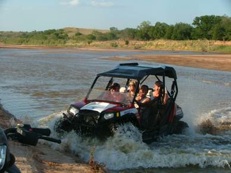




When Disaster Strikes
How do you categorize a disaster? Mainstream media tends to use statistics and numbers to express the impact disasters bring. In reality there is no way to quantify devastation when human lives are lost. Storms can be scientifically measured and destruction may be claimed, but what the human soul endures and how it copes can’t be measured.
It has been two months since the tornados of May tore through Oklahoma, and yet the damage left in their wake is still noticeable. However, the damage would be much more noticeable if not for the volunteers of the many organizations that aided Oklahomans in their time of need. Devoted people such as the trained volunteers of the Southern Baptist Disaster relief call-out crews offer stepping stones for rebuilding. Under the direction of Sam Porter of the Oklahoma Baptist General Convention, the disaster relief call out crews combined their efforts with other state Baptist conventions, including those from Idaho and Utah to methodically help the Moore and Shawnee areas. Amidst the chaos of destruction the state conventions worked closely with the Red Cross to orchestrate restoration, which provided a light at the end of the tunnel for many Oklahomans.
The Southern Baptist Disaster relief ministry began in Texas in 1967, creating a mission to share the love of Jesus Christ with those who have been impacted by a disaster. Within ten years, nine other surrounding states also developed disaster relief ministries of their own. The Southern Baptist disaster relief ministry now consist of over 80,000 trained volunteers nation wide, making them the largest group of trained volunteers for disasters in America. Their relief is broken down into two areas including both mass care and recovery operations.
Mass care consists of feeding, sheltering, and counseling those affected by disasters. In conjunction with the Red Cross, the Southern Baptist Disaster relief provides meals with their highly effective mobile kitchens. In fact nearly 95% of Red Cross meals come from their mobile kitchens.
The second phase of their relief efforts is recovery operations. This is where they assist homeowners start their rebuilding process. They do this by cleaning up debris with chainsaws and heavy equipment. Mark Madison has worked countless disasters. As the Director for Disaster Relief for the Salt Lake Baptist Association, he has seen the impact of using heavy equipment during the relief progress. He commented on the use of heavy equipment for their recovery operations.
“Donated equipment is critical to our clean up effort. Logistically, equipment is essential because it can get a lot done with very little man power. The benefits of having donated equipment such as the Kubota skid steer from Great Plains can’t be stressed enough. I’ve seen everything from Kubota tractors and backhoes to the skid steer that were used in Moore, all of which are important for safety and productivity,” Madison stated.
Don Nesbitt has been on call out crews for this ministry since 2006. His recent deployment to the Moore, Okla. area lasted about a week. During this time he served on a chainsaw crew and primarily cut down trees that had fallen on houses. As a volunteer for both the Southern Baptist Disaster relief and the Red Cross, Nesbitt’s life focuses on being prepared for the next chance to serve, no matter what the need might be. Nesbitt commented on the joy he gets from being a part disaster relief call-outs crews.
“I think people appreciate knowing someone has made time and effort to help, both with physical cleanup and the concern for them personally. This has been the common response in every disaster relief I’ve been on, and it was true for Moore as well. I really like seeing a big mess cleaned up. Even more, I like getting to know the people we help. Being a Christian, my greatest joy is to see how someone’s life has been blessed because Jesus called to serve. I can not give to any effort more than what I receive. I am very blessed to be able to help,” said Nesbitt.
The help offered by volunteers during these times goes beyond shelter and cleanup. It literally saves lives. A recent letter accounts where one team was working with a woman whose home had been demolished and she was obviously very depressed. This was
a large job that took several days in which this team
prayed with her, shared with her, and listened to her. On the last day the woman confided to the team that she was alone and previously believed that no one cared for her, not even God, and that she had decided to commit suicide. She testified that it was their ministry and caring that ultimately changed her mind.
Perhaps the most important disaster relief this organization provides is relief of the soul. Long after the clean up crews have gone and houses have been rebuilt, the love of Jesus Christ shared by these volunteers will still be there. Among all the volunteered groups that organize and combine efforts the one true credit goes to whom they serve, Jesus.
It is said that the best things in life are fee. The cleanup efforts of the volunteers are certainly free to the recipients, but costly to the volunteers who sacrificed their time and money to help others. The message of spending eternity with God shared by the volunteers was also free, but came at a great cost to God as he sacrificed his son, Jesus Christ, to die on the cross for our sins. The relief of the soul comes from the simple acceptance of this ultimate sacrifice.

